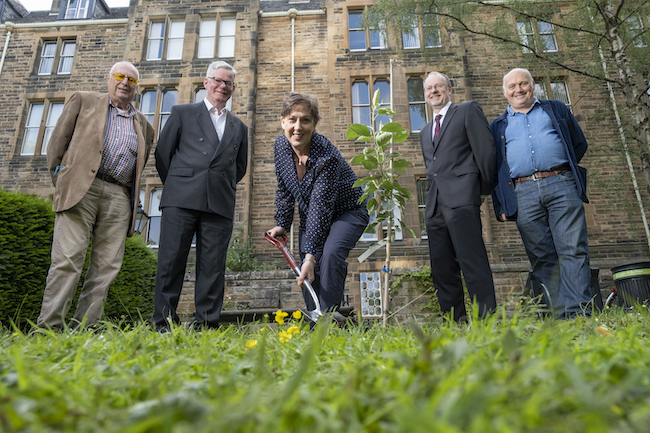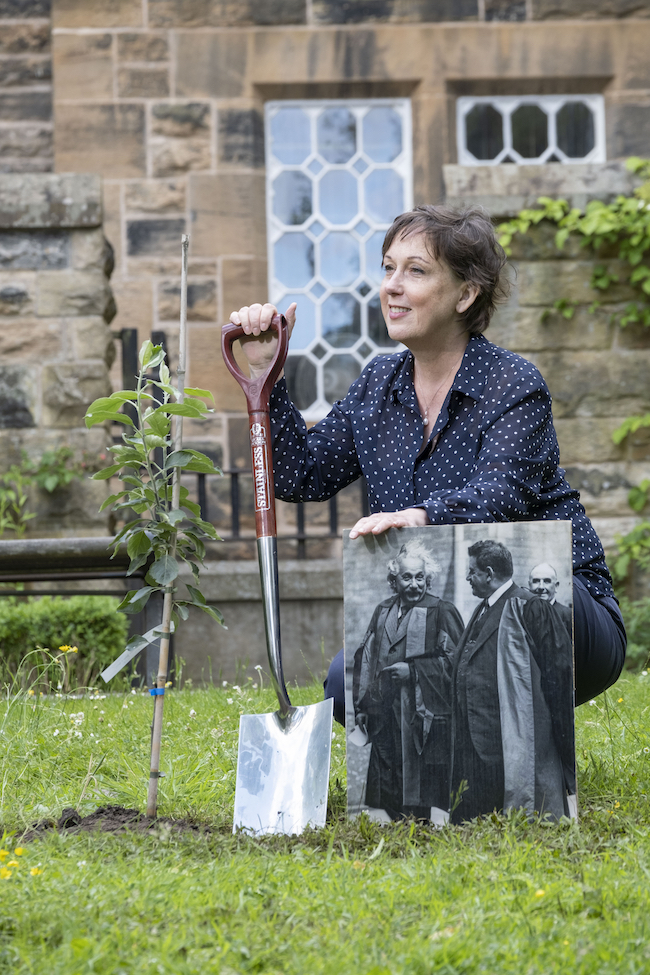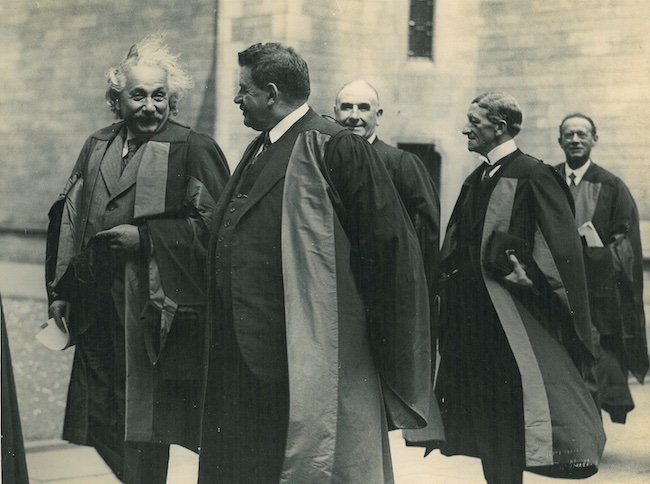UofG celebrates links to Einstein with tree planting ceremony
Published: 26 June 2023
The University of Glasgow is celebrating its links to Albert Einstein by planting a cutting on campus taken from an apple tree in his summer home.
The University of Glasgow is celebrating its links to Albert Einstein by planting a cutting on campus taken from an apple tree in his summer home.
Researchers from the School of Physics & Astronomy planted the Holsteiner cox apple tree cutting on Monday 26th June, 90 years since Einstein visited the city and received an honorary degree from the University in recognition of his contribution to physics. 
Einstein predicted the existence of gravitational waves – ripples in the fabric spacetime caused by massive astronomical events like the merger of black holes – in 1916 as part of his general theory of relativity.
Researchers from the University’s Institute for Gravitational Research (IGR) were part of the international collaboration which discovered the first direct evidence of gravitational waves in 2015, finally confirming his theory a century later.
Glasgow scientists developed the mirror suspension technology at the heart of the Laser Interferometer Gravitational-wave Observatory (LIGO) which made the detection possible.
LIGO, the most sensitive scientific equipment ever developed, is capable of detecting the very faint traces of gravitational waves as they pass through the Earth. The suspensions help hold 40kg mirrors completely still so lasers bounced from their surfaces can measure the tiny displacement the gravitational waves cause – a movement of around 1/10,000th the width of a proton.
The LIGO-Virgo-KAGRA network of gravitational wave detectors began its fourth observing run on May 24th. Glasgow researchers continue to play key roles in the data processing and analysis which underpins each detection, and will contribute to future upgrades which aim to make the detectors even more sensitive. The network expects to detect signals from hundreds of new astronomical events during its 18-month run.
Professor Sheila Rowan, director of the Institute for Gravitational Research, said: “Albert Einstein’s theories laid the foundations for much of modern physics, and we’re proud that our predecessors at the University of Glasgow had the opportunity to present him with an honorary degree in recognition of his work.
“A century later, gravitational wave astronomy has given us a whole new way of observing the universe, helping us to detect the previously undetectable, and Glasgow researchers are important parts of the LIGO-Virgo-KAGRA network.
“We’re delighted to be able to plant a tree from Einstein’s garden here at the University today. It’s inspiring to think that a tree from Einstein’s garden will be growing on campus at the same time that our understanding of the universe grows through gravitational wave astronomy.”
The cutting from Albert Einstein’s tree was donated by John Hancox, a graduate of the University’s School of Chemistry who runs the social enterprise Scottish Fruit Trees. The cutting was arranged by the Einstein Forum in Berlin and the James Clark Maxwell Foundation.
The original tree is on the grounds of Einstein’s home in Caputh, Germany, where he spent time before fleeing the Nazis. The cutting was planted beside the Kelvin Building, where the School of Physics & Astronomy is based.
John Hancox said: “As a science graduate of the University of Glasgow, it’s lovely to be able to supply this tree in part to contribute back to the University. There is a personal connection too, as my Mum was from Berlin and in my mind this is also a quiet memorial to her as well.
“The Holsteiner cox is a nice eating apple and it would be nice to think that the tree might inspire the next generation of scientists in making significant advances. As anyone knows the story of how Isaac Newton developed his theory of gravity can tell you, apples have played a key role in the story of physics before now and they might once again.”
 Einstein visited the University in June 1933. On June 20th, he delivered a lecture on general relativity and his work. The next day, he was officially presented with an honorary LL.D at the University’s graduation ceremony.
Einstein visited the University in June 1933. On June 20th, he delivered a lecture on general relativity and his work. The next day, he was officially presented with an honorary LL.D at the University’s graduation ceremony.
First published: 26 June 2023
<< June

